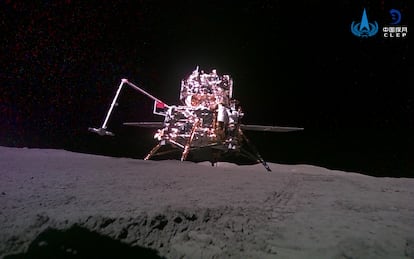The Chinese probe ‘Chang’e 6′ brings samples from the far side of the Moon to Earth for the first time in history
China becomes the first nation capable of successfully landing a robotic module in that unexplored region, collecting dust and rocks, and transporting them back to our planet

The far side of the Moon, the hemisphere that we never see from Earth, was an absolute mystery until the Soviet probe Lunik 3 took its first photograph in 1959. Six decades later, China has become the first nation capable of landing a robotic module in that unexplored region, a feat that no other country has emulated. On Tuesday the Asian giant achieved a new milestone, successfully completing its most complex robotic lunar mission to date, Chang’e 6, with which it has managed to land on the most remote part of the Moon, collect two kilos of lunar dust and rocks, transfer them to the return module and transport them back to our planet within the planned period of 53 days.
Scientists hope that these samples will shed light on the origins and evolution of not only our closest celestial body, but the entire solar system, while many analysts anticipate that the mission has important strategic and geopolitical implications. Beijing is determined to consolidate its presence in the cosmos and considers its space program a fundamental pillar of its plan to become a great economic, technological and diplomatic power of the 21st century.
The Chang’e 6 probe landed without incident in Inner Mongolia, in the north of the country, at 2:08 p.m. local time, as reported by the China National Space Administration. Images broadcast by Chinese state television CCTV showed how the capsule carrying the samples descended by parachute from bright blue skies until it fell into the steppes, where scientists collected it.
The Moon’s most remote hemisphere looks very different from what we see from Earth, with an older, thicker crust and many more craters. Experts believe that the samples obtained on this mission could have a different chemical composition than those recovered from the most visible side by the American Apollo missions (launched in the 1960s and 1970s) or by China’s Chang’e 5 (2020). For this reason, they consider that their analysis could help understand why both sides are so different, and they hope that the results will provide new clues about the formation of celestial bodies. “They are expected to answer one of the most fundamental scientific questions in lunar research: What geological activity is responsible for the differences between the two faces?” said Zongyu Yue, a geologist at the Chinese Academy of Sciences, in a statement.
The Chang’e 6 probe launched on May 3 aboard the country’s most advanced rocket model, the Long March 5, and landed on June 2 at the Apollo impact crater, about 520 kilometers in diameter, located within the vast Aitken Basin of the lunar south pole. This gigantic lunar depression (2,500 kilometers in diameter and 12 kilometers deep) was formed about 4 billion years ago and is believed to contain frozen water, a resource that could be key for manned missions. The lunar south pole is, in fact, the new goal to explore, since access to water would significantly increase the chances of successfully establishing a human base on the Moon.
In addition to the difficulties of maneuvering due to the topography of the terrain, the technical complexity of the mission was aggravated by the fact that communication with the probe could not be direct, since the Moon’s own mass causes the modules to lose the signal. Although much of the process has been automated, communication for the Moon landing and lunar liftoff has been facilitated by the Queqiao 2 relay satellite, which was launched in March.
To carry out the sampling, the rover explorer drilled into the ground and collected samples with a robotic arm. Once the process was completed, the probe extended a robotic arm to raise China’s five-star red flag, according to information published by the space agency. The ascent module took off on June 4 carrying the capsule with the materials and docked with the system that continued in orbit two days later.
The Chang’e program, focused on the exploration of the Moon, is named in honor of a goddess who, according to Chinese tradition, inhabits the Moon. The first mission of this project was launched in 2007 and, in the last five years, it has achieved great feats. In 2019, Chang’e 4 was the first probe capable of landing on the far side of the Moon. A year later, with Chang’e 5, the Asian giant became the third country capable of transporting lunar material, something that until then only the United States and the Soviet Union had achieved.
But the aspirations of Beijing, which has been investing billions of euros in its space exploration projects for years, go much further. In 2026, it plans to launch Chang’e 7 to study the resources of the lunar south pole and, in 2028, Chang’e 8 will take off with the mission to check how to use those resources in situ and test their most advanced technology. In addition, it intends to send a pair of taikonauts – Chinese astronauts – to the lunar surface before 2030.
Developing its capabilities to access Moon resources (such as water ice, helium-3 and rare earths) would demonstrate China’s maturity as a space power and consolidate its attractiveness as an international partner in complex missions. The fact that Chang’e 6 launched on the announced date adds reliability to China’s timelines for its planned future missions.
The Chang’e program is also paving the way for the creation of the International Lunar Research Station (ILRS), the base being developed by the Chinese space administration and Russia’s Roscosmos and whose construction is planned for the early 2030s. Although for Chang’e 6 China has had the collaboration of the European Space Agency (ESA), France and Italy, for now the EU has not made a decision about whether it will maintain that cooperation in other projects. It is known that it will not participate in ILRS, because space collaboration with Russia is currently under embargo.
Sign up for our weekly newsletter to get more English-language news coverage from EL PAÍS USA Edition
Tu suscripción se está usando en otro dispositivo
¿Quieres añadir otro usuario a tu suscripción?
Si continúas leyendo en este dispositivo, no se podrá leer en el otro.
FlechaTu suscripción se está usando en otro dispositivo y solo puedes acceder a EL PAÍS desde un dispositivo a la vez.
Si quieres compartir tu cuenta, cambia tu suscripción a la modalidad Premium, así podrás añadir otro usuario. Cada uno accederá con su propia cuenta de email, lo que os permitirá personalizar vuestra experiencia en EL PAÍS.
¿Tienes una suscripción de empresa? Accede aquí para contratar más cuentas.
En el caso de no saber quién está usando tu cuenta, te recomendamos cambiar tu contraseña aquí.
Si decides continuar compartiendo tu cuenta, este mensaje se mostrará en tu dispositivo y en el de la otra persona que está usando tu cuenta de forma indefinida, afectando a tu experiencia de lectura. Puedes consultar aquí los términos y condiciones de la suscripción digital.
More information
Archived In
Últimas noticias
NASA discovers Titan doesn’t have an ocean, but a ‘slushy ice layer’ that increases possibility of life
Innocence lost in the forest of the child soldiers: ‘Each leader of the armed group had his girls’
‘Fallout’ or how the world’s largest company turned an anti-capitalist apocalyptic Western into a phenomenon
From inflation to defending migrants: Eileen Higgins and Zohran Mamdani inaugurate the new Democratic resistance against Trump
Most viewed
- ‘El Limones’ and the growing union disguise of Mexican organized crime
- Christian Louboutin: ‘Young people don’t want to be like their parents. And if their parents wear sneakers, they’re going to look for something else’
- The low-cost creative revolution: How technology is making art accessible to everyone
- ‘We are dying’: Cuba sinks into a health crisis amid medicine shortages and misdiagnosis
- A mountaineer, accused of manslaughter for the death of his partner during a climb: He silenced his phone and refused a helicopter rescue











































